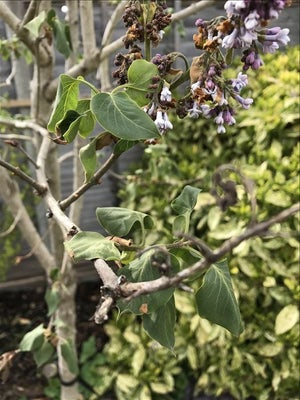
Quick facts
Common name - Lilac blight
Scientific name - Pseudomonas syringae pv. syringae
Plants affected - Chinese, Japanese, Persian and common types of lilac. However all types may be affected.
Main symptoms - Leaf spots, leaf shrivelling, cankers on stems, blossom and bud blackening, wilt and die back of stems.
Caused by - Bacterium
Timing - Symptoms begin to develop soon after new shoots emerge in spring.
What is lilac blight?
Lilac blight is caused by the bacterium Pseudomonas syringae pv. syringae. Many ornamental plants and edible crops are affected by host-specific strains (pathovars, abbreviated to pv.) of Pseudomonas syringae. Pseudomonas syringae pv. syringae differs by having a wide distribution on woody plants and can also affect stone fruit trees, as well as Vaccinium (blueberry) and Forsythia.
The pathogen is capable of living on the surface of the plant in a harmless epiphytic state until the right conditions occur for it to enter the plant and cause disease.
Pruning and other cultural measures can be used to control the disease in gardens. It can be a more serious problem in a nursery setting, and can spread rapidly with overhead watering systems.
Plants suffering from wounds, water stress, frost damage, lack of nutrition and other pathogens have shown increased susceptibility to infection.
Symptoms
You may see the following symptoms:
- Spots: The first symptoms are normally angular brown spots on leaves and stems. These coalesce to form large areas of blight.
- Blackening: Blackening occurs at the margins and/or along the central vein of newer leaves, moving downwards. These leaves can then shrivel and drop. Buds also looked scorched and blackened with blossoms browning and shrivelling.
- Canker: Canker lesions develop on stems
- Die back: Dieback occurs on young shoots; blackening and curling into a ‘shepherd crook’ shape. Branches can also show dieback.
N.B. The blackened appearance of affected shoots can resemble the effects of frost damage. Leaves and young shoots damaged by lilac blight are sometimes then colonised by the grey mould pathogen, Botrytis cinerea.

Control
The RHS believes that avoiding pests, diseases and weeds by good practice in cultivation methods, cultivar selection, garden hygiene and encouraging or introducing natural enemies, should be the first line of control. If chemical controls are used, they should be used only in a minimal and highly targeted manner.
Non-chemical control
- Lilac blight is difficult to control as the bacteria are readily dispersed by wind and rain. Because the disease is favoured by cool, wet conditions it can be naturally restricted during periods of hot, dry weather. Avoid overhead watering of young plants to help prevent spread of the bacteria.
- It is best to prune out affected twigs and branches as soon as you notice them. Make your pruning cut at least 6-8 inches below the infected area into healthy wood. Do not prune when leaves are wet as this could further spread the infection. Spread can be further mitigated by disinfecting your tools between cuts.
- Ensure fallen leaves are raked up and disposed of (by burning, burial or consigning to the council green waste) as the pathogen can overwinter on plant debris.
- Weakened plants can be more susceptible to lilac blight and the impact of this disease on such plants can be more severe. Try to maintain overall good health of lilacs by pruning them in the spring, once they have finished flowering, to increase air circulation.
- Do not over fertilise (especially young plants) late in the season, and ensure you are using a balanced fertiliser; the use of high nitrogen fertilisers can result in a large amount of soft new growth that is more susceptible to infection. In general lilacs do not require much fertiliser.
- Young trees are more susceptible to the disease than mature ones. There is some evidence that white flowered varieties are more susceptible and dwarf varieties less so.
Chemical control
There are no fungicide sprays available to home gardeners for the control of lilac blight.
Biology
The bacterium favours wet, cool conditions with infection likely to occur in winter or spring. The pathogen can overwinter in cankers and other diseased plant material like twigs and leaves. It can lay dormant until the right conditions for development occur. It is most commonly spread from affected tissues by the wind and rain, but can also be spread via insect vectors and pruning tools.
Disease occurs when the pathogen enters the plant through wounds or natural openings like the stomata (air pores) in the leaves, and releases toxins which by-pass the plant's immune system and damage plant cells. The pathogen then multiplies in the apoplast (the spaces between plant cells). The effects of this damage typically manifest in the new growth first. Leaf and shoot infections can expand, girdling the stems and disrupting nutrient and water supply, which causes the die back. The dieback can be limited to just the young shoots with the woody branches remaining intact.
Infected plants can have a greater susceptibility to frost damage, due to the bacterium producing a protein which helps to form ice crystals both inside and outside the plants. As the crystals grow they pierce the plant cells and create wounds through which more bacteria can enter, making colonisation easier.
Lilac blight is profoundly influenced by external conditions. For example stomata open in response to high atmospheric humidity, which could promote bacterial entry into the plant.




